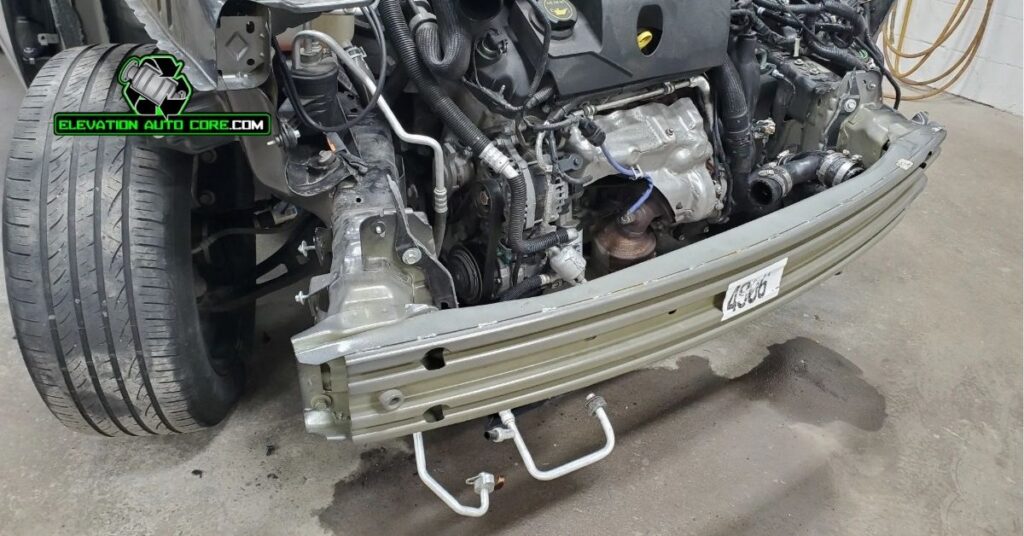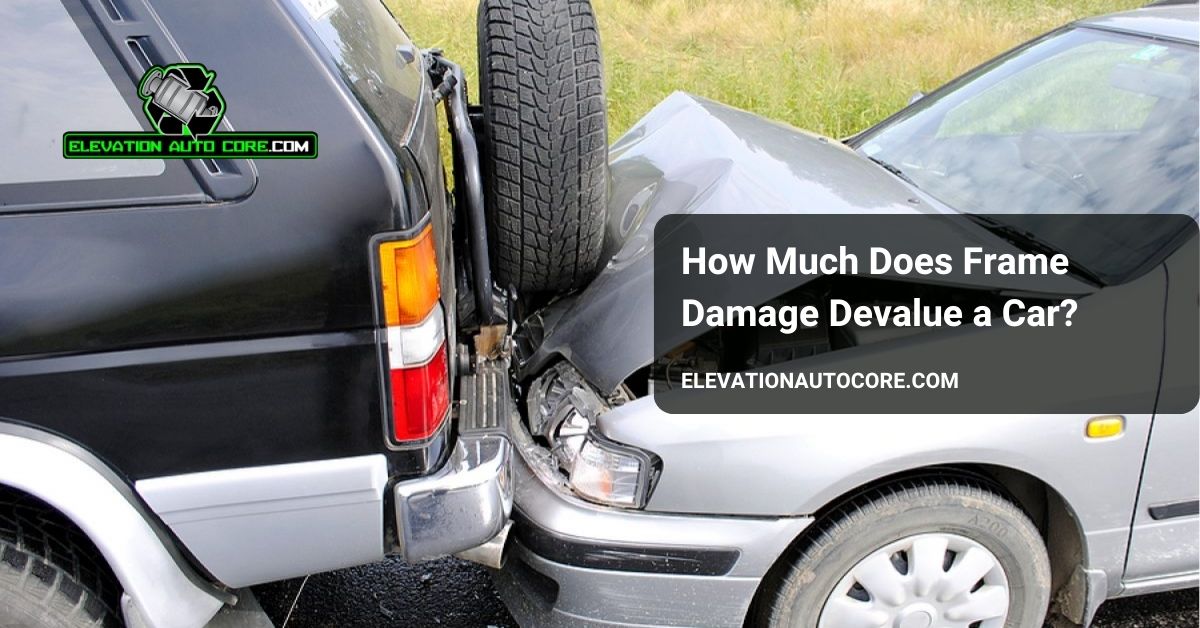How much does frame damage devalue a car? If you’re considering selling or buying a vehicle with frame damage, you’re likely wondering just how much it impacts value. Frame damage isn’t just a cosmetic issue—it can significantly affect a car’s safety, performance, and market appeal. Keep reading to understand the key factors that determine how much value is lost and what it means for your wallet.
What Is Frame Damage?

Frame damage refers to structural harm that affects a car’s chassis or support system. It compromises the vehicle’s integrity and impacts safety, performance, and resale value.
Understanding The Basics
A car’s frame serves as its foundation, supporting its components and protecting passengers. When damaged, the structure’s strength and alignment weaken. This can lead to issues with stability, handling, and crash protection. Vehicles with frame damage are often less reliable, even after repairs.
Damage can affect unibody frames, which combine the body and frame into one piece, or ladder frames, typically used in larger vehicles like trucks. Both types experience reduced durability following structural harm.
Common Causes Of Frame Damage
Collisions are the most frequent cause, ranging from minor accidents to severe impacts. Even low-speed crashes can misalign or bend the frame.
Poor road conditions, such as potholes or debris, can also stress the structure over time. Vehicles repeatedly exposed to rough driving environments develop weaknesses in critical areas.
Natural disasters, including floods or falling debris, can harm the frame’s integrity. Water exposure weakens metal components, while heavy objects can cause physical deformation.
Impact Of Frame Damage On A Car’s Value

Frame damage significantly reduces a vehicle’s resale value. Structural issues linked to frame damage affect safety, performance, and perception among potential buyers.
Why Frame Damage Matters To Buyers
Buyers typically view frame damage as a red flag. Cars with compromised frames often struggle to meet safety and performance expectations, even after professional repairs. Common concerns include reduced crash protection, alignment problems, and increased maintenance costs.
Insurance companies may classify cars with frame damage as rebuilt or salvage-titled. This designation can deter buyers and lower the car’s market value. Dealerships and private buyers tend to offer significantly less for cars with structural harm, fearing hidden repair costs or irreversible damage.
Factors Influencing The Devaluation
The extent of frame damage plays a major role in determining value loss. Severe damage, such as bent or twisted sections, leads to a greater depreciation compared to minor harm. The visibility of the damage impacts buyer interest; noticeable structural issues reduce perceived quality and reliability.
Repair quality also affects resale value. Poorly executed fixes might restore functionality temporarily but fail long-term durability tests. Professional inspections revealing subpar repairs further decrease the vehicle’s appeal.
Market demand for the car’s make and model can influence devaluation. Popular models may retain slightly better value even though frame damage, while niche or low-demand vehicles experience sharper depreciation.
Assessing The Severity Of Frame Damage

Understanding the severity of frame damage helps determine its impact on a vehicle’s safety, performance, and resale value. Evaluating such damage requires careful inspection and consideration of the vehicle’s repair history.
Inspection And Identification
Begin by inspecting the car’s structural components for visible signs of damage or deformities. Crumpled sections, misaligned panels, or uneven gaps around doors and windows often indicate compromised frame integrity. Pay attention to the underside of the vehicle, especially around the frame rails, cross members, and suspension mounting points, as these areas typically sustain the most stress during collisions.
Professional diagnostic tools can reveal less obvious structural issues. Frame alignment checks measure deviations from manufacturer specifications, confirming how significantly the frame’s structure has been altered. In cases where damage stems from severe impacts, frame cracks or weakened welded joints become more apparent under detailed examination.
Role Of Repair History
A documented repair history offers insights into how well frame damage was addressed. High-quality repairs performed by certified technicians usually involve precision methods, like frame-straightening machines and advanced welding techniques. Vehicles repaired with proper tools and factory-approved parts retain slightly better structural integrity and market appeal.
Incomplete or improperly executed repairs weaken critical frame areas over time. Signs of poor repair work include inconsistent welds, use of aftermarket parts, and uneven paint finishes. Buyers often seek transparency about repair history since trust in repairs often influences resale negotiations.
Is It Worth Repairing?
Frame damage significantly affects a car’s value and safety. Deciding whether to repair or sell hinges on weighing repair costs against the car’s potential worth.
Cost Of Repairs Vs. Devaluation
Repairing frame damage often involves substantial expenses. Frame repair costs typically range from $500 to $10,000, depending on the severity. Minor straightening tends to fall on the lower end, while damages requiring welding or replacement escalate costs.
Repairs don’t always fully recover a car’s value. Even professionally repaired vehicles frequently face value reductions of 20% to 50%. For example, a car valued at $20,000 before frame damage could drop to $10,000 post-repair due to lingering structural concerns or the stigma of previous damage.
Professional repairs improve structural integrity, but long-term durability can depend on the repair quality. Skipping a certified repair facility to save costs risks a poorly executed job, which further devalues the car. Weighing repair expenses against potential resale or trade-in value helps determine the better option.
Selling A Car With Frame Damage
Selling a car with frame damage challenges your ability to attract buyers. Vehicles with structural issues often receive salvage or rebuilt titles, which reduces their appeal and limits market demand.
Transparency proves essential when selling such cars. Providing repair records reassures potential buyers that the damage was properly addressed. Disclosing visible damage helps build trust and prevents legal disputes over undisclosed issues.
The market for cars with frame damage includes private buyers, dealerships, and specialized salvage yards. Private buyers willing to negotiate may accept the damage for reduced prices. Dealerships typically offer low trade-in values. Salvage yards often purchase frame-damaged vehicles for parts or scrap, but their offers fall well below market value.
Tips For Buyers And Sellers

Frame damage greatly influences a vehicle’s value, requiring careful considerations for buyers and sellers. Planning your approach will help you avoid financial risks and build trust in transactions.
Advice For Buyers
Start by inspecting the vehicle’s frame condition. Visible issues like bent sections or misalignments point to structural weaknesses. If damage is not apparent, request an inspection by a certified mechanic with diagnostic tools.
Review the repair history closely. Repairs performed by trained technicians using quality materials are more reliable. Incomplete or poorly executed repairs weaken the frame further, raising safety concerns.
Verify the vehicle’s title status. Rebuilt or salvage titles indicate past important damage and typically reduce resale value. It’s essential to assess whether potential future repairs and depreciation justify the purchase.
Negotiate effectively with documented information. Use repair records and inspection reports to determine how much the damage devalues the car, guiding you in offering a reasonable price.
Strategies For Sellers
Disclose frame damage upfront. Buyers value transparency, and clear communication about damage builds trust in the transaction. Provide documentation, such as repair invoices and inspection reports, to verify the condition.
Set realistic expectations for price reduction. Frame-damaged cars typically lose 20% to 50% of their value, depending on severity and repair quality. Adjust your asking price accordingly to attract serious buyers.
Consider targeting the right market. Private buyers, dealerships, or salvage yards may offer different levels of value for your car. Research their offers and weigh convenience against potential monetary return.
Highlight any professional repairs. Repairs completed by certified technicians using OEM parts improve buyer confidence. Stress the safety and performance reinstated through these repairs to boost interest.
Conclusion
Understanding how frame damage affects a car’s value is essential whether you’re buying or selling. It’s not just about the visible damage but the long-term impact on safety, performance, and marketability. Transparency, thorough inspections, and realistic pricing play a key role in handling these transactions.
If you’re selling, being upfront about the damage and providing repair records can build trust and attract the right buyers. As a buyer, careful evaluation of the vehicle’s condition and repair quality ensures you make an well-informed choice. With the right approach, you can minimize risks and maximize value, even with frame damage in the equation.

